Chad Pregracke and Bison Bridge Forum Begin Push for Public Support, Private Funding
The morning after he gave a visionary talk on repurposing the I-80 bridge across the Mississippi River, Chad Pregracke was back at The Rust Belt Friday to push the process of gathering public support for the planned Bison Bridge.
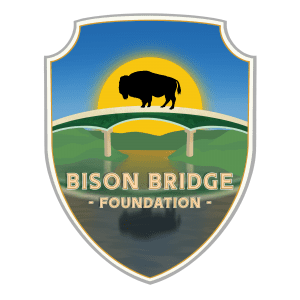
The logo for the Bison Bridge Foundation.
Jake Ford, director of government affairs with the Quad Cities Chamber, led a morning legislative forum on the project with Pregracke, president/founder of Living Lands & Waters; Matthew Hughes, consultant with MRH Solutions,
Kevin Marchek, retired engineer from the Illinois Department of Transportation, and Illinois state Sen. Neil Anderson.
Before the meeting, Quad Cities Chamber President & CEO Paul Rumler said the project will help the region attract and retain people as well as investment, and “really put the Quad-Cities on the map.” Once Quad Citizens hear the details, he added, “We hope everybody else will sign on and support this plan.”
The long-term vision is to turn the existing I-80 bridge into Bison Bridge — and the acreage on either side of the Mississippi River adjacent to the bridge into a new National Park. Visitors will have the chance to learn about the history of the prairie, native wildlife, and the historical significance of the river.

Paul Rumler is president/CEO of the Quad Cities Chamber.
With over 42,000 cars a day traveling over the Mississippi on I-80, the Bison Bridge will attract locals and visitors alike for the chance to experience all the river and the region have to offer, according to project supporters.
Completed in 1966, the four-lane, 3,483-foot-long Fred Schwengel Memorial Bridge connects the Q-C between LeClaire, Iowa, and Rapids City, Ill. In 2020, the Illinois Department of Transportation began a preliminary study to replace the bridge. (The bridge was renamed in 1995 in honor of the former Iowa Congressman.)
After forming Living Lands & Waters in 1998, Pregracke has had this bridge idea for 20 years, to make this an iconic attraction for the region.
“There’s not a better bridge,” he said Thursday, noting it’s 65 feet wide, and like a rolling hill. “For what I want to do, there is not a better bridge.”
LL&W has been working on prairie restoration next to the bridge on the Illinois side.

Chad Pregracke, founder of Living Lands & Waters.
The project’s reveal comes as the Illinois Department of Transportation is studying the future of the 55-year-old infrastructure and preparing to make decisions about the location and design of a new I-80 replacement bridge.
At the Rust Belt event — dubbed “A Historic Night in the Quad Cities” — Pregracke outlined the Bison Bridge Foundation’s vision for transforming the aging bridge into a one-of-a-kind national treasure. The project would showcase and celebrate America’s second longest river and national mammal – the American bison.
The project is much more than the bridge, but all the lands around it, almost 100 acres on both sides of the river.
The true “out of the box” is including a small herd of bison in the westbound lane – creating the largest wildlife bridge crossing in the world, Pregracke said. “Bison could literally eat their way over to Iowa and eat their way back to Illinois,” he said.
Kevin Marchek, who worked over 39 years for IDOT, said Friday: “It’s a fantastic idea, a heck of a vision. We’ve just got to keeping pushing this until it comes to fruition.”
Bison Bridge has potential to save the state millions of dollars in demolition costs. “That’ll be a huge benefit to the state too,” he said. The
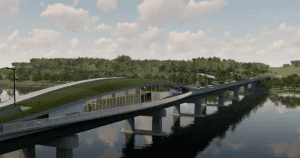
The planned renovation of the bridge, for wildlife, pedestrians and bikers.
three-phase process for a new I-80 bridge will be looking at environmental impacts, designs and plans, and the last phase is construction, which would take seven years before building, Marchek said.
“Time really flies when you start working on a project like this,” he said. “We’re right at the perfect spot now, at the beginning.”
“What a great vision,” Neil Anderson said. “People need to focus on the broad spectrum of this idea. The Mississippi River is not only something that everybody knows around the world, but it what makes the Midwest the Midwest.”
“To me, it’s something I think we’ve been missing a lot of – that’s bringing families together,” he said. “It’s just a great vision and I really appreciate being here, being part of this.”
Anderson said that combined with all the other outdoor activities that go on in the Q-C, they want to get more people “to stop, see it and enjoy it,” he said. “I can’t think of anything better than having families drive through the Quad-City area, stop and see something that they’ve never seen before – both as far as infrastructure and something native to the Midwest, in bison that unfortunately have been gone for far too long.”
No public funding required
Ford from the chamber asked about Bison Bridge funding: Pregracke is not looking for public money, and plans to finance it all privately.
“When you’re talking about a national park, people get excited about it,” he said. “I don’t even think most of the money’s gonna come from
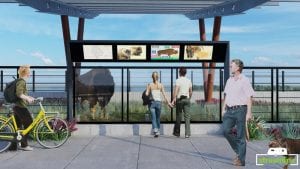
A planned viewing area on the repurposed pedestrian bridge.
this area.”
Two of the LL&W board members said money is not going to be a problem, he said.
Pregracke did not announce numbers Thursday or Friday, and said they don’t know what the cost estimates will be. He noted the St. Louis Gateway Arch visitor center was completed in 2018 at a $367-million cost, through a public-private partnership.
“Do I expect this to cost that? Absolutely not,” Pregracke said of the bridge project. “But it’s a perfect example of things happening. We think it’s very doable and there’s examples where these things have been done,” he said.
Hughes, the infrastructure consultant, has been chief financial officer at Illinois DOT and went to high school and college with Pregracke.
“We’ve made a lot of progress. Though we’re just publicly announcing this in the last 24 hours, we’ve done a lot of work, touched a lot of bases, checked a lot of boxes,” he said, noting they’ve been working on this for two years.
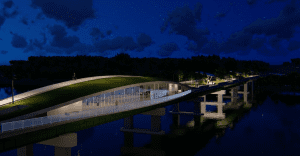
A rendering of the Bison Bridge at night, with a raised bike trail and meeting space below.
“It’s important to note that we’re not going to taxpayers and asking to finance this,” Hughes said.
Echoing what he said Thursday night, Pregracke on Friday morning in the livestreamed session said: “The truth is, guys, we’re not even on the map. If you’re under 30 years old, you live in Chicago, I can guarantee 9 out of 10 have never heard of the Quad-Cities.”
Pregracke is not asking for money, but the Foundation has a goal of 50,000 signatures from people who want to see this, to let the DOTs in Iowa and Illinois know.
“I’ve built great relationships outside the Quad-Cities,” he said, noting TV celebrities Mike Rowe
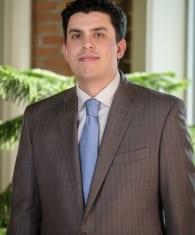
Jake Ford is the director of government affairs for the Quad Cities Chamber.
and Mike Wolfe, who will help spread the word.
Ford said the chamber is always looking for cool, unique things that bring people to the area, as well as business investment.
“I liked what you said about the families and the quality of life around here,” Pregracke said to Ford. “That’s what truly drove this home for me, to make this a destination. If it is designated a national park, it would certainly be a destination, and we have so much other things to offer than just a bridge.”
“The bridge gets them here and then they can experience all the other great things we have here,” he said. “It will put us back on the map.”
Of the other speakers, Pregracke said: “I’ve been so blessed to have these guys helping navigate how to make something like this happen.”
Aligning with chamber and tourism goals
Ford said after the forum Friday that John Deere has been a big backer of Bison Bridge (helping put together Pregracke’s multimedia presentation), and the chamber and Visit Quad Cities are among strong supporters.
“It’s certainly something that aligns with our overall goals of bringing more people here and retaining investment, expanding the population
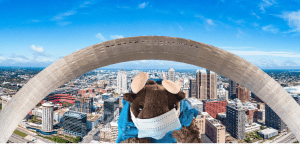
Buddy Bison (seen at the Gateway Arch in St. Louis) is the mascot for the National Park Trust.
and a big, bold idea that we think will again bring people,” Ford said.
“We know Chad’s got a lot of fans and followers around here. So it was a win-win for the chamber to be able to talk to our members about how they could support this and also to relay the message,” he said of holding the Rust Belt talk Friday.
Everyone knows it will be a long, complicated process, working with the two states and Federal Highway Administration, Ford said. “It’s not a quick process. There’s a lot of steps that will have to be taken. But the thing that we always worry about, especially in the state of Illinois, is are you asking for a lot of funding and this is a private investment,” he said. “So we don’t have to go to legislators and say, can you work this into the capital budget? Can you look within your operating budget? We’re really just asking for their support and make sure that constituents know about it.”

Neil Anderson
“Sen. Anderson did a great job this morning of talking about, it would provide a great opportunity for families to get out there and experience it, but also probably bring jobs to build all this and for people to maintain it,” Ford said. “So the legislative process at this point is not, we don’t have to run a bill. Ford agreed with Pregracke’s comments Thursday night about the need to stanch the flow of Q-C and Illinois losing population.
“We have conversations all the time about how we need to get our workforce pipeline stronger,” Ford said. “And one of the chamber’s goals is increased population before 2030. So when talking about people leaving the state of Illinois, he’s right there. And, when he says, this will put us on the map.
“That means more visitors one, but also more people that might want to visit and then say, ‘Wow, this is really great place,’” he said. “Maybe we should think about living there, so it drives investment. I think if there’s a national park here, and then all of a sudden people are saying, this is a reason to stop in the Quad-Cities. Maybe we should build a restaurant there. Maybe we should expand there, so no, he’s not exaggerating.” “It’s a goal of ours again to just increase the population. We think this would be a good way to continue to do that,” Ford said.
“You hear it all the time. These cool, bold, unique ideas that really separates us from other towns where you could decide to live, decide to work or even decide to visit,” he added. “So he fits right into the mold of what we’re talking about when we wanna drive people here.”
Ford and the chamber admire all the groundwork Pregracke and his partners have done, including researching what other cities have done similarly with vacated bridges.
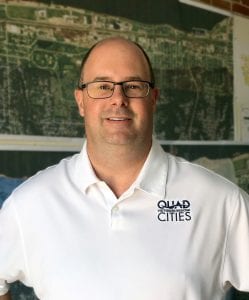
Dave Herrell is president/CEO of Visit Quad Cities.
“So we’re always willing to look at other places that have used ideas or funding ideas, things like that,” Ford said. “Chad, he’s been in those places. It’s not just that he researched these. He’s been there. He’s been on the ground to actually see kind of how these transformations take place. So I think he’s the perfect guy.”“He’s energetic, he gets it. He’s done his homework, and he’s got all the partners around,” he said.
“This touches our tourism master plan on so many levels,” Dave Herrell, president and CEO of Visit Quad Cities, said Thursday.
In what is a very competitive tourism landscape, he said destination organizations tend to focus on marketing their existing attractions. “But to be able to take an old asset and repurpose it into something new, I think that’s the secret sauce.”
Herrell said the Bison Bridge project not only will set the Q-C region apart from all its Mississippi River counterparts, but it will also raise its visibility as a destination nationally and internationally.
With concerns for health and safety heightened by Covid, he said, “The outdoors is going to be more and more critical as we think of what we want to be as a destination and how we take our global asset – the Mississippi River – and elevate it to a new level.”
The Bison Bridge group’s goal is to sign up 50,000 supporters, to show Iowa and Illinois transportation departments. You can sign up at https://bisonbridge.org/support.
You can watch the entire March 18 event (79 minutes) at https://specialevents.brand.live/c/bison-bridge. And you can see Friday’s chamber forum at https://youtu.be/erBlo-kanZI.


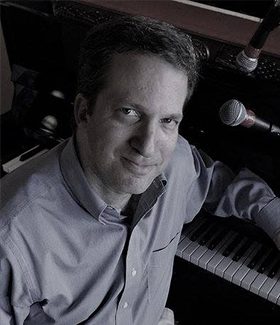
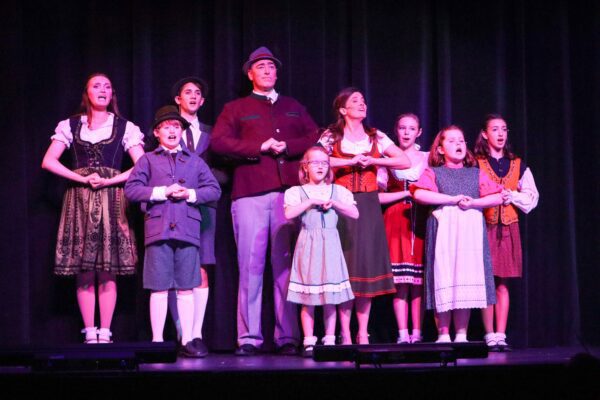
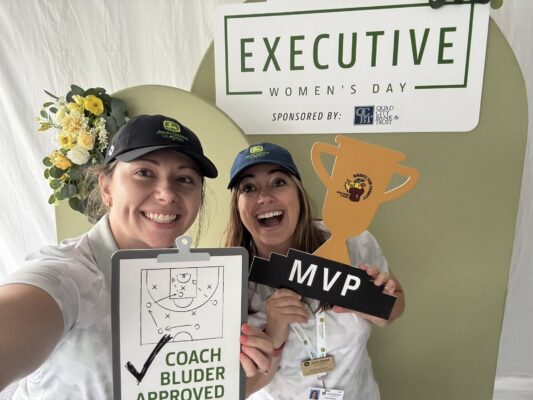
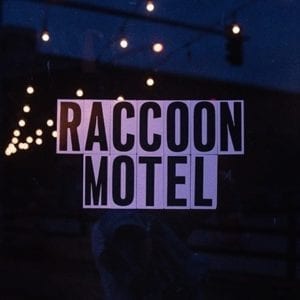







Leave a Reply
You must be logged in to post a comment.